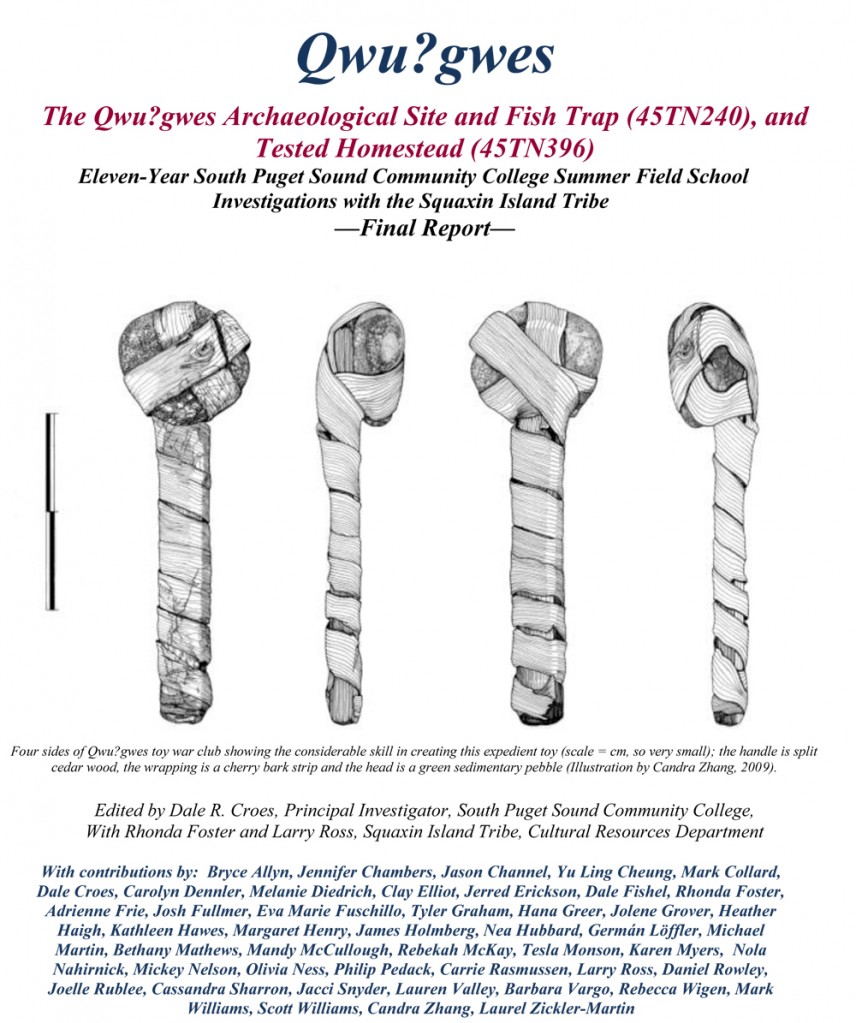This final Qwu?gwes wet site report has been accepted by the Washington State Department of Archaeology and Historic Preservation–if you would like to download a pdf go to:Â Qwu?gwes Final Report with data Appendices
OR a two column version (1/2 size) with out the data Appendices:Â Qwu?gwes Final Report in 2-column Polished Format
Qwu?gwes (45TN240) is located on Mud Bay at the southern end of Eld Inlet, Puget Sound, near Olympia, Washington. The site was named Qwu?gwes, a term in the indigenous Lushootseed language meaning a place to come together, share, and gather by the Squaxin Island Tribe in 2000 (Foster and Croes 2002). It describes a place where academic scientists and students and the cultural experts from the Squaxin Island Tribe strove to work in a cooperative partnership to better describe and explain the ancient history of this location. The ancient people and villages of this inlet were known as the “Squi-Aitl.â€
The site consists of an area above the beach where food resources were processed, an intertidal shell midden, and an area where those gathering and processing would have temporarily lived. Also present nearby is a fish trap complex at the end of Orr Cove, northeast of the Qwu?gwes shell-midden (both considered 45TN240) and a homestead area to the southeast of Qwu?gwes that is associated with the original Donation Land Claim (45TN396).
Qwu?gwes is archaeologically significant because it (1) is the first substantial excavation of a site in all of south Puget Sound, (2) includes a waterlogged preserved section containing examples of wood and fiber artifacts in a major resource camp, and (3) contains a distinct record of shellfish and fisheries used at this camp.
From the beginning, the research and analyses for this multi-year field school project have been approached from two, equally important perspectives: (a) the scientific descriptive analyses and (b) the cultural explanatory analyses, both involving tribal representatives and archaeologists following the goal of an equal partnership through the 11+ years. These views are often complementary and provide a more comprehensive overview and place from which to offer joint interpretations of the ancient history of Qwu?gwes. The Qwu?gwes project has always been an educational training effort, not just a rescue excavation. Less than 35 cubic meters (2.3%) of the site have been excavated during the past 11 summer seasons of investigation. The 55, 1×1 meter units excavated by 2009 clearly revealed examples of three use areas: (1) a temporary habitation area, (2), a shellfish and other foods processing area, and (3) an inter-tidal waterlogged discard shell-midden area on the beach. These three distinct use areas serve as the focus of comparison for the data sets summarized here. 

Leave a Reply